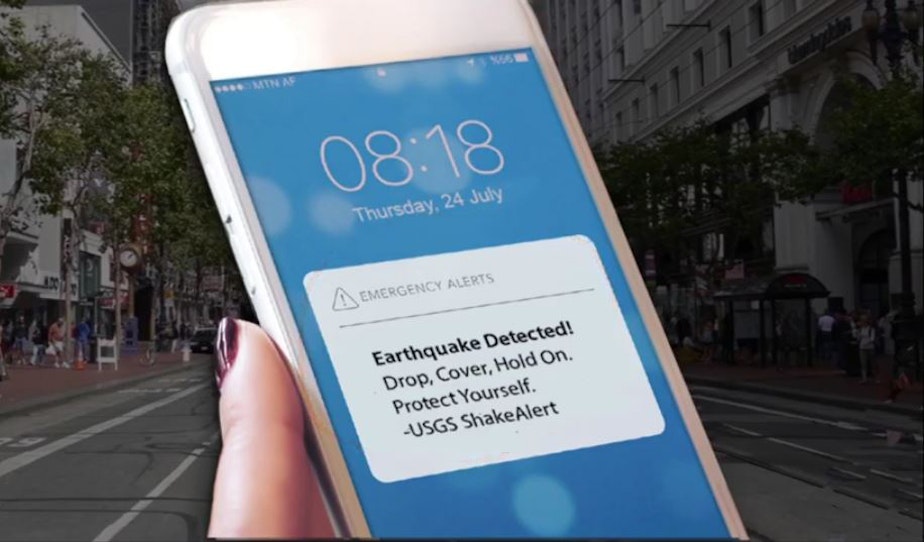ShakeAlert test part of long-awaited earthquake preparedness plan

Alarms will be ringing from phones throughout the Northwest Thursday as the region tests ShakeAlert for the very first time.
The early warning system for your smartphone aims to notify people when an earthquake is quickly coming their way. The system will be up and running in Oregon next month and Washington this spring.
KUOW’s regional correspondent Tom Banse explains how it works.
This interview has been edited for clarity.
First of all, what is this technology and how does it work?
Banse: It’s pretty cool stuff. First off, I should underscore that this is not earthquake prediction. This tool relies on a newly expanded network of seismometers to detect an earthquake once it strikes, and is therefore mainly useful when you're at least a little distance away from the quake epicenter.
The reason this works is that electronic signals and radio waves travel much faster than earthquake rumbling propagates through the surface of the earth. Let's say there's a strong quake at the Pacific coast. There's a dense network of sensors at the coast. They triangulate the location and estimated magnitude of the quake and beam that data to a central computer in Seattle that calculates what geographic area could be affected by strong shaking.
That computer automatically triggers a prepared warning message to go out over all the cell towers inside identified geography. All this electronic action is supposed to happen in a matter of seconds, which leaves a few more seconds, maybe as much as half a minute in our example, for people in the Puget Sound metro area to react before the shaking arrives where they are.
Sponsored
What will people see when this warning pops up?
Banse: It's going to be just like an Amber Alert. You'll probably jump right out of your shoes when you hear that blaring noise. At that point, it boils down to having to keep things really basic, because you might just have a few seconds to process in your brain what that alarm is about and what to do.
The emergency alert message heading is simply "Earthquake Detected!," followed by "Drop, cover, hold on, protect yourself." The good thing is, most of us have probably practiced what to do since we were students in grade school.
Beyond alerting us to do that, which hopefully is ingrained, are there other ways that this technology could be used to save lives?
Banse: There definitely are. This is a really interesting area to keep an eye on because there is a range of startups I'm hearing that are signing agreements with the U.S. Geological Survey to get access to that warning code data. Then those private companies are inventing and marketing devices that perform an automatic shutdown or a safety action.
Sponsored
For example, a water utility could buy an automated valve that protects its reservoirs from draining. If the earthquake breaks a bunch of water mains down the hill, a fire department could program the garage doors on fire stations to open in the seconds before the shaking starts so they don't jam later and trap the fire trucks inside just when we need them most.
One more example, Sound Transit or Amtrak could add an automatic trigger that slows down trains and light rail automatically when the earthquake warning alarm goes off so they're not going so fast when those rails ahead start buckling.
This technology is already online, in other places in the U.S. and some other countries as well. Has it helped save lives in other places?
Banse: It has. Japan, China, Mexico, and Turkey are some of the places that already have this technology. I'm most familiar with Japan where the earthquake warning system is integrated with tsunami warnings, too. That proved very valuable 10 years ago, during the magnitude 9 Great Tōhoku earthquake. Some people along the Japanese coast heard sirens go off, like we have, to tell them to evacuate, but many more got the message on their smartphones saying “Go, Go, Go. Major tsunami expected.”
If Japan has had this technology for at least 10 years, why has it taken so long for the ShakeAlert technology to get going here?
It has been a long time coming, and it's not even completely built out yet. The USGS didn't have to reinvent the wheel, because this exists elsewhere, but the government had to install hundreds upon hundreds of seismic sensors over all known earthquake faults in Washington, Oregon, and California. Then funding just came in dribs and drabs from Congress.
At this point, the sensor network is about 70% complete for the West Coast, I'm told, with slightly more than 1,100 out of the planned 1,675 seismic stations installed as of a few weeks ago.
Thursday's test is for people in King, Pierce, and Thurston Counties. If you want to take part, you'll need to opt-in. You can find instructions at mil.wa.gov/alerts
Listen to the interview by clicking the play button above.





